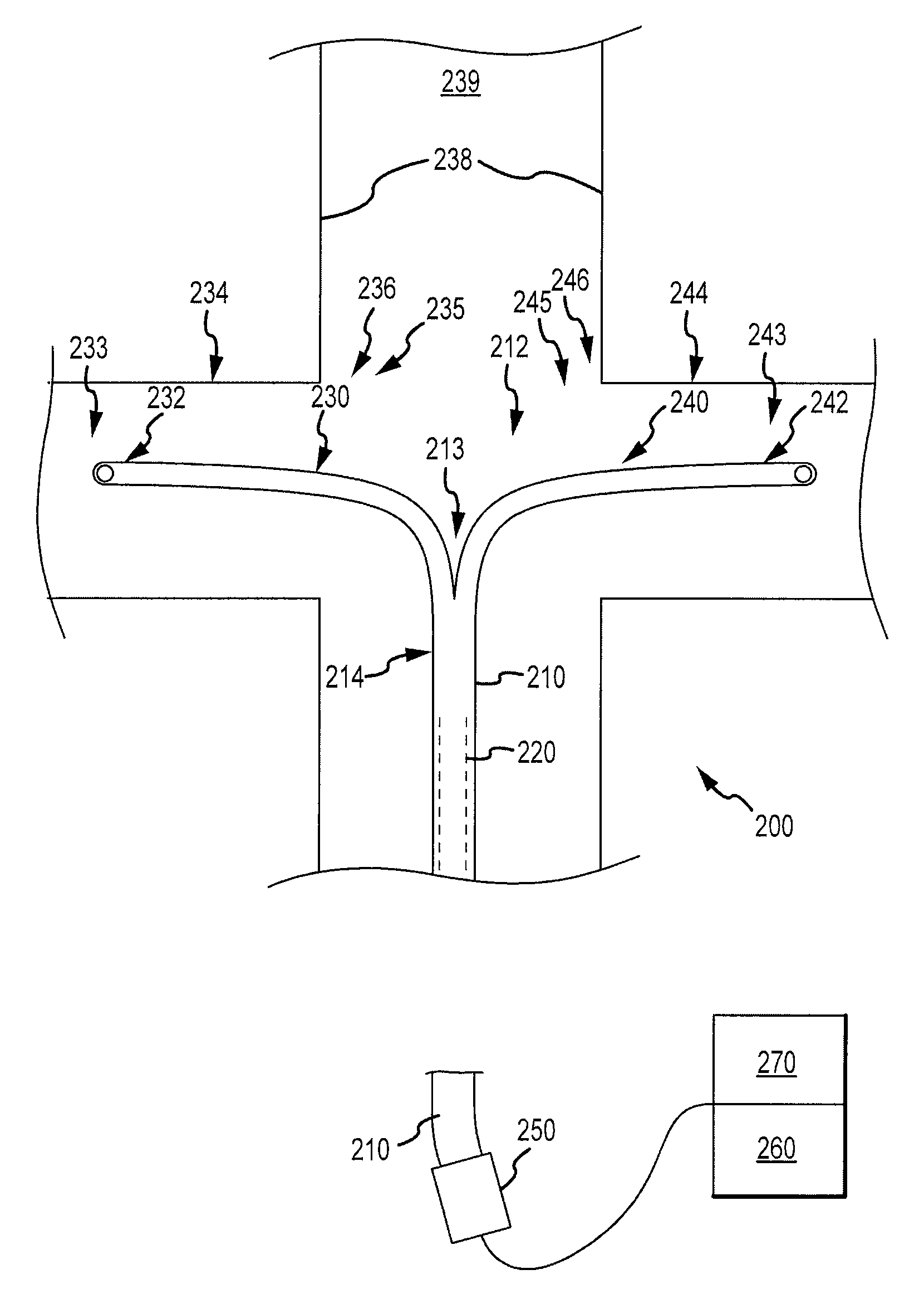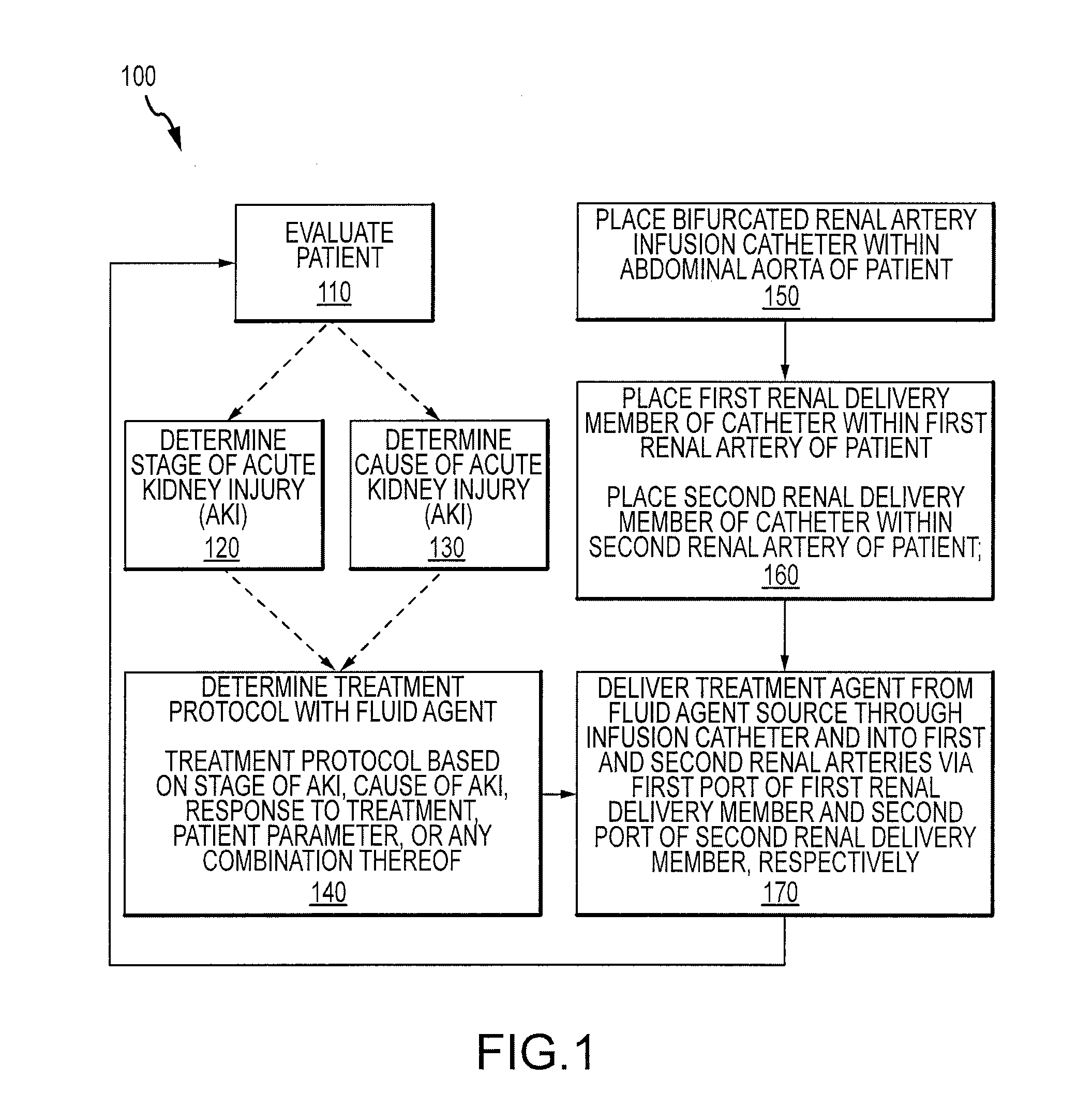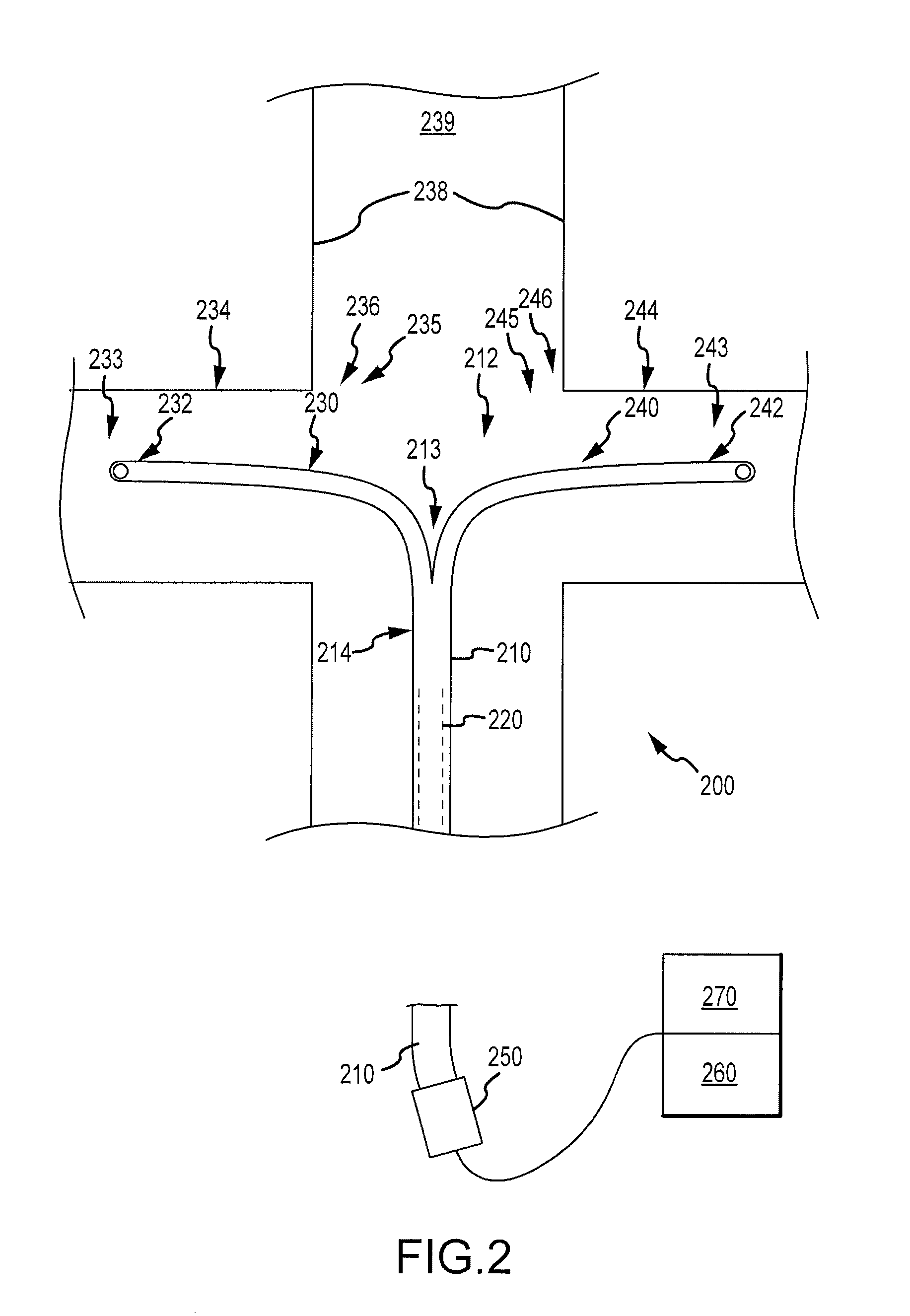[0020]In still a further aspect, embodiments of the present invention encompass a system and method for treating a patient suffering from acute kidney injury, where the kidney injury is caused by a kidney tumor or cancer. The system can include a bifurcated renal artery infusion catheter placed via percutaneous means. The bifurcated catheter can include a distal bifurcated portion and a proximal tubular portion, a catheter lumen traversing the length of the non-bifurcated proximal tubular portion of the catheter's length, a first renal delivery member with a first distal port that is adapted to be delivered to a first delivery position within a first renal artery via a first corresponding renal ostium located at a first location along an abdominal aorta wall of an abdominal aorta in a patient, a second renal delivery member with a second distal port that is adapted to be delivered to a second delivery position within a second renal artery via a second corresponding renal ostium located at a second location along the abdominal aorta wall that is different than the first location, a bifurcation joining the distal bifurcated portion and proximal tubular portion of the catheter and providing for fluid communication between the two renal delivery members and the catheter's inner lumen, and a proximal coupler assembly that is adapted to be located externally of the patient when the first and second distal ports are positioned at the first and second delivery positions, respectively. The proximal coupler assembly can be coupled to the catheter's inner lumen so as to deliver material from outside the patient's body via the proximal coupler assembly, through the catheter inner lumen, through the first and second renal delivery members, and into the first and second distal ports at the first and second delivery positions, respectively, and into the first and second renal arteries, also respectively. The system may also include a therapeutic agent source located externally to the patient. The therapeutic agent can include one or more of a vasodilator, an antioxidant, an anti-inflammatory agent, a cytokine, or a neurohormonally-active agent. Further, the system may include a means of delivering said therapeutic agent through said renal artery catheter via its proximal coupler to each of the first and second distal ports substantially within first and second renal arteries simultaneously or substantially simultaneously. The kidney tumor or cancer may be related to renal cell carcinoma. The vasodilator can be fenoldopam mesylate or an analog or derivative thereof, or dopamine or an analog or derivative thereof. In some cases, the vasodilator is a prostaglandin or analog or derivative thereof. The antioxidant can be, for example, sodium bicarbonate or acetylcysteine. In some cases, the cytokine can be a lymphokine, such as interleukin-2, or a genetically engineered or modified version thereof. In some cases, the neurohormonally active agent is a natriuretic peptide, or an analog or derivative thereof. The natriuretic peptide can be A-type natriuretic peptide, B-type natriuretic peptide, or C-type natriuretic peptide. The natriuretic peptide can be a synthetic or bio-engineered natriuretic peptide. An intra-renally delivered agent can be dosed according to the patient's weight. Optionally, the intra-renally delivered agent can be administered at a fixed infusion rate regardless of the patient's weight. The agent can also be delivered at a variable infusion rate independent of the patient's weight. In some cases, the means of delivering the agent through the catheter is an infusion pump.
[0021]In another aspect, embodiments of the present invention encompass a method for treating a patient suffering from acute kidney injury, where the kidney injury is defined as one or more of an increase in serum creatinine by at least 50% over baseline, a reduction in glomerular filtration rate of at least 25% compared to baseline, or a decrease in urine output to 0.5 ml per kilogram of body weight or less per hour persisting for at least 6 hours. The method can include providing a percutaneous bifurcated renal artery infusion catheter placed within first and second renal arteries of the patient, where renal artery catheter includes a proximal coupler located externally to the patient in fluid communication with first and second delivery ports. The method can also include providing a therapeutic agent source located externally to the patient, in fluid communication with the proximal coupler of the bifurcated renal artery infusion catheter, where the therapeutic agent includes one or more of a vasodilator or an antioxidant. Further, the method can include delivering the therapeutic agent through the renal artery catheter via its proximal coupler to each of the first and second distal ports substantially within first and second renal arteries simultaneously or substantially simultaneously. In some cases, the kidney injury is caused by a toxic agent. The toxic agent can be radiocontrast media or a chemotherapy agent, for example. In some cases, the kidney injury is pre-renal in nature. For example, a pre-renal kidney injury can be caused by reduced cardiac output, reducing overall blood flow to the kidneys. In some cases, a pre-renal kidney injury is caused by systemic hypotension. Systemic hypotension can be caused by cardiorenal syndrome or acute decompensated heart failure. In some cases, a pre-renal kidney injury can be caused by a reduction in circulating volume due to hemorrhage. Similarly, the pre-renal kidney injury may have occurred post surgery. Optionally, the pre-renal kidney injury may have been caused by a reduction in local renal blood flow caused by hepatorenal syndrome. In some cases, the vasodilator is fenoldopam mesylate or an analog or derivative thereof, or dopamine or an analog or derivative thereof. Optionally, the vasodilator is a prostaglandin or analog or derivative thereof. In some cases, the antioxidant is sodium bicarbonate or acetylcysteine. An intra-renally delivered agent can be dosed according to the patient's weight. Optionally, the intra-renally delivered agent can be administered at a fixed infusion rate regardless of the patient's weight. The agent can also be delivered at a variable infusion rate independent of the patient's weight. In some cases, the means of delivering the agent through the catheter is an infusion pump.
[0022]In another aspect, embodiments of the present invention provide a method for treating a patient suffering from acute kidney injury, where the kidney injury is defined as one or more of an increase in serum creatinine by at least 100% over baseline, a reduction in glomerular filtration rate of at least 50% compared to baseline, or a decrease in urine output to 0.5 ml per kilogram of body weight or less per hour persisting for at least 12 hours. The method can include providing a percutaneous bifurcated renal artery infusion catheter placed within first and second renal arteries of the patient, where the renal artery catheter includes a proximal coupler located externally to the patient in fluid communication with first and second delivery ports. The method can also include providing a therapeutic agent source located externally to the patient, in fluid communication with the proximal coupler of the bifurcated renal artery infusion catheter, where the therapeutic agent includes one or more of a vasodilator, an antioxidant, an anti-inflammatory agent, or an antibiotic. Further, the method may include delivering the therapeutic agent through t...
 Login to View More
Login to View More  Login to View More
Login to View More 


